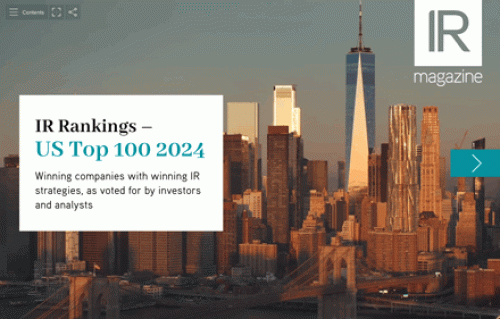What is IR like in the US? And how does it compare with other markets?
This article was produced in association with ELITE Connect. It was originally published on the ELITE Connect platform.
While the principles and purpose remain the same, subtle differences exist between IR in the US and its global counterparts. Often, these differences are the result of regulation, but they can also be down to preferred business culture.
For example, while global IR tends to favor roadshows (averaging 8.6 per year*), the US prefers industry conferences (averaging 7.1 annually compared with 5.7 roadshows). This decision is often in response to Regulation Fair Disclosure (Reg FD), which rules that publicly traded companies must disclose material information to all investors at the same time. As conferences are mostly webcast and publicly available, Reg FD compliance is achieved.
Roadshows, meanwhile, help to highlight the way the US market can be more short-term focused than others. ‘Our senior management feedback is always great from European roadshows,’ says Nils Paellmann, head of IR at T-Mobile US. ‘This is mainly due to European investors having a longer-term strategic focus, which contrasts with the short-term momentum and quarterly focus often seen in the US.’
A US IR snapshot
• Smaller teams: The US falls slightly behind the global average of 2.6 team members, with 2.2
• Greater CFO reporting: 71 percent of IR teams report to the CFO compared with the global average of 64 percent
• Bigger budgets: US budgets average $507,000, compared with the $491,000 globally
• Fewer one-on-one meetings: US meetings average 159, fewer than the 204 global average
• More senior management one-on-ones: Despite fewer meetings, 52 percent of US one-on-ones involve senior management versus 44 percent globally
• Less international travel: The US’ position as the biggest market for equity assets means fewer international trips. Last year’s top five destinations for US IR teams were New York, Boston, Chicago, San Francisco and Los Angeles
Overcoming economic uncertainty is a current challenge, with fears of US recession returning to the fore, as Paellmann comments: ‘Investors are definitely distracted by the potential of another period of recession. We’re seeing a renewed level of investor caution, with many potential investors seeking reassurance on what will happen to business models if recession strikes again.’
Another concern – particularly with proxy season close at hand – is the influence of proxy advisers. ‘The fact that Glass Lewis and ISS, the two US-based advisory firms, have a large roster of clients means they can have an extraordinary influence on the outcome of director appointments and other proxy voting matters,’ comments Ruth Cotter, senior vice president of HR, corporate communications & IR at AMD.
‘This is especially concerning for smaller public companies that, in many cases, don’t have access to the advisory firms to the extent larger companies may, meaning there really isn’t a level playing field.’
And the solution? ‘The SEC introduced some guidelines last year, but it needs to do more,’ Cotter concludes. ‘We need more robust regulation to create equal information access during proxy season that will benefit shareholders and companies alike.’
*All data in this article is sourced from IR Magazine










